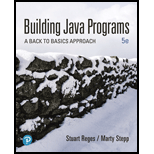
Concept explainers
Interaction with super class
Program plan:
- Create a class “Employee”,
- Define the method “getHours()” to return “40”.
- Define the method “getSalary()” to return “40000.0”.
- Define the method “getVacationDays()” to return “10”.
- Define the method “getVacationForm()” to return “yellow”.
- Create a class “Marketer” that extends the super class “Employee”,
- Define the method “advertise()” ,
- Print the string.
- Define the method “getSalary()”,
- Call the method “getSalary()” of super class and return the updated value.
- Define the method “main()”,
- Create object for “Marketer” class.
- Call the method “advertise()”.
- Print the value returned from “getsalary()”.
- Define the method “getSalary()”,
- Print the string.
- Define the method “advertise()” ,
This program demonstrates the class that accompanies the other law firm classes.
Explanation of Solution
Program:
File name: “Employee.java”
//Create a class
public class Employee
{
//Define the method
public int getHours()
{
//Retunr "40"
return 40;
}
//Define the method
public double getSalary()
{
//Return "40000.0"
return 40000.0;
}
//Define the method
public int getVacationDays()
{
//Return "10"
return 10;
}
//Define the method
public String getVacationForm ()
{
//Return "yellow"
return " yellow";
}
}
File name: “Marketer.java”
//Create a class
public class Marketer extends Employee
{
//Define the method advertise()
public static void advertise()
{
//Print the string
System.out.println("Act now, while supplies last!");
}
//Define the method
public double getSalary()
{
/*Call the method of super class and return the updated value*/
return super.getSalary() + 10000;
}
//Define the main() method
public static void main(String[] args)
{
//Create object
Marketer m=new Marketer();
//Call the method
m.advertise();
//Print the value returned from getSalary()
System.out.println("$"+m.getSalary());
}
}
Output:
Act now, while supplies last!
$50000.0
Want to see more full solutions like this?
Chapter 9 Solutions
MyProgrammingLab with Pearson eText -- Access Code Card -- for Building Java Programs
- what is a feature in the Windows Server Security Compliance Toolkit, thank you.arrow_forwardYou will write a program that allows the user to keep track of college locations and details about each location. To begin you will create a College python class that keeps track of the csollege's unique id number, name, address, phone number, maximum students, and average tuition cost. Once you have built the College class, you will write a program that stores College objects in a dictionary while using the College's unique id number as the key. The program should display a menu in this order that lets the user: 1) Add a new College 2) Look up a College 4) Delete an existing College 5) Change an existing College's name, address, phone number, maximum guests, and average tuition cost. 6) Exit the programarrow_forwardShow all the workarrow_forward
- Show all the workarrow_forward[5 marks] Give a recursive definition for the language anb2n where n = 1, 2, 3, ... over the alphabet Ó={a, b}. 2) [12 marks] Consider the following languages over the alphabet ={a ,b}, (i) The language of all words that begin and end an a (ii) The language where every a in a word is immediately followed by at least one b. (a) Express each as a Regular Expression (b) Draw an FA for each language (c) For Language (i), draw a TG using at most 3 states (d) For Language (ii), construct a CFG.arrow_forwardQuestion 1 Generate a random sample of standard lognormal data (rlnorm()) for sample size n = 100. Construct histogram estimates of density for this sample using Sturges’ Rule, Scott’s Normal Reference Rule, and the FD Rule. Question 2 Construct a frequency polygon density estimate for the sample in Question 1, using bin width determined by Sturges’ Rule.arrow_forward
- Generate a random sample of standard lognormal data (rlnorm()) for sample size n = 100. Construct histogram estimates of density for this sample using Sturges’ Rule, Scott’s Normal Reference Rule, and the FD Rule.arrow_forwardCan I get help with this case please, thank youarrow_forwardI need help to solve the following, thank youarrow_forward
 Database System ConceptsComputer ScienceISBN:9780078022159Author:Abraham Silberschatz Professor, Henry F. Korth, S. SudarshanPublisher:McGraw-Hill Education
Database System ConceptsComputer ScienceISBN:9780078022159Author:Abraham Silberschatz Professor, Henry F. Korth, S. SudarshanPublisher:McGraw-Hill Education Starting Out with Python (4th Edition)Computer ScienceISBN:9780134444321Author:Tony GaddisPublisher:PEARSON
Starting Out with Python (4th Edition)Computer ScienceISBN:9780134444321Author:Tony GaddisPublisher:PEARSON Digital Fundamentals (11th Edition)Computer ScienceISBN:9780132737968Author:Thomas L. FloydPublisher:PEARSON
Digital Fundamentals (11th Edition)Computer ScienceISBN:9780132737968Author:Thomas L. FloydPublisher:PEARSON C How to Program (8th Edition)Computer ScienceISBN:9780133976892Author:Paul J. Deitel, Harvey DeitelPublisher:PEARSON
C How to Program (8th Edition)Computer ScienceISBN:9780133976892Author:Paul J. Deitel, Harvey DeitelPublisher:PEARSON Database Systems: Design, Implementation, & Manag...Computer ScienceISBN:9781337627900Author:Carlos Coronel, Steven MorrisPublisher:Cengage Learning
Database Systems: Design, Implementation, & Manag...Computer ScienceISBN:9781337627900Author:Carlos Coronel, Steven MorrisPublisher:Cengage Learning Programmable Logic ControllersComputer ScienceISBN:9780073373843Author:Frank D. PetruzellaPublisher:McGraw-Hill Education
Programmable Logic ControllersComputer ScienceISBN:9780073373843Author:Frank D. PetruzellaPublisher:McGraw-Hill Education





